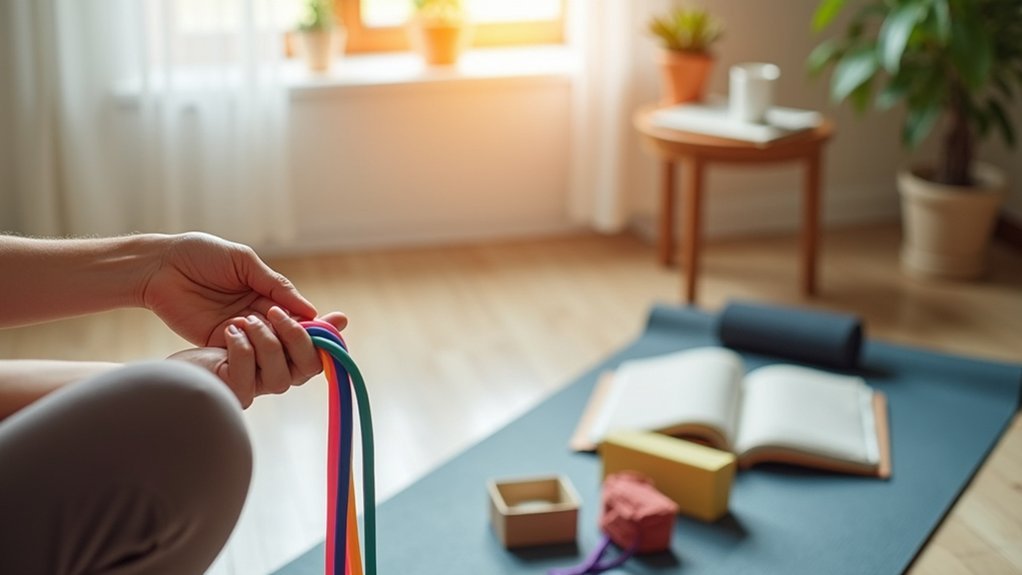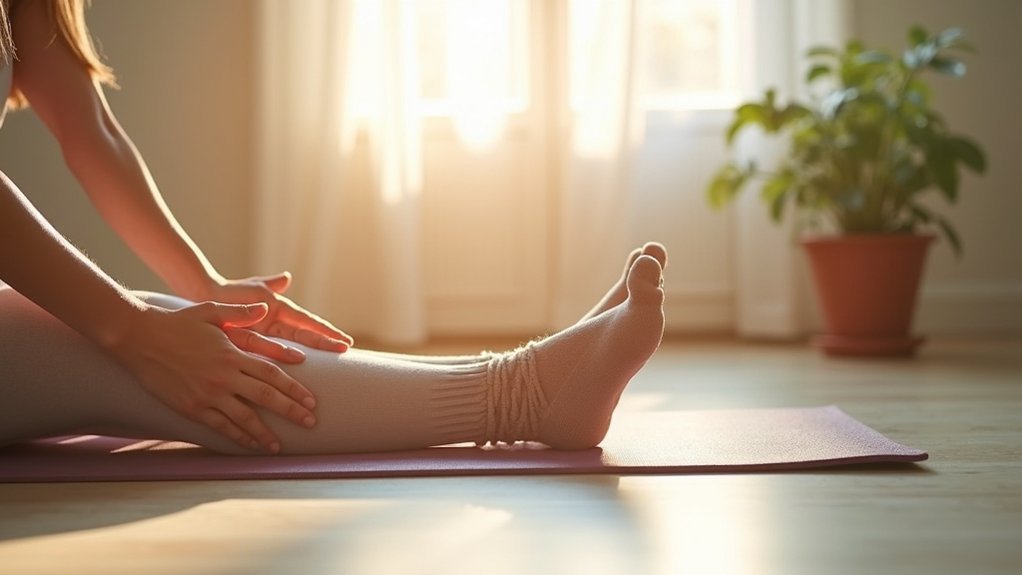Gentle mini-exercises ease joint discomfort by increasing blood flow, delivering oxygen and nutrients to your joints for healing. These movements stimulate synovial fluid production, which reduces friction between joint surfaces. Low-impact activities like rebounding or simple shoulder rolls strengthen supporting muscles while minimizing strain. Even 5-10 minutes of gentle motion can improve flexibility and decrease stiffness. Discover how incorporating these brief routines into your daily schedule can transform your joint health long-term.
The Science Behind Joint Pain Relief Through Movement

While it may seem counterintuitive to move when your joints hurt, gentle motion is actually one of the most effective remedies for discomfort. Your body responds positively to low-impact exercises that don’t strain already sensitive areas.
When you perform gentle movements, you’re increasing blood flow to your joints, delivering essential oxygen and nutrients needed for healing. These exercises stimulate production of synovial fluid—your body’s natural joint lubricant—reducing friction and pain with each movement.
Regular activity builds muscle strength around your joints, creating better support structures that distribute weight more evenly. As you improve flexibility through these mini-exercises, you’ll notice increased range of motion and decreased stiffness.
Building support through exercise: strengthening the muscles around your joints creates a natural framework for improved mobility.
Research confirms that consistent gentle movement can actually lower inflammatory markers in your body, addressing joint pain at its biochemical source.
How Gentle Rebounding Stimulates Synovial Fluid Production
Whenever you gently bounce on a mini-trampoline or other soft surface, you’re activating one of your body’s most powerful joint-healing mechanisms. This rhythmic motion stimulates the production of synovial fluid, your joints’ natural lubricant, which reduces friction during movement.
As you rebound, the alternating compression and decompression creates a pumping action that circulates this crucial fluid throughout your joints. This enhanced flow delivers essential nutrients to cartilage, maintaining cartilage integrity and protecting against wear and tear.
You’ll notice improved joint mobility and flexibility with regular gentle rebounding sessions. The increased synovial fluid helps alleviate stiffness and discomfort, contributing to better overall joint function.
Just a few minutes daily can help maintain ideal fluid levels for healthier, more comfortable joints.
Starting Your Low-Impact Rebounding Journey

When you first step onto a mini-trampoline, hold onto a stable chair or wall until you’ve mastered your balance and feel confident standing unsupported.
You’ll want to begin with just 5-10 minutes of gentle bouncing two to three times weekly, focusing on maintaining proper posture rather than height or speed.
As your stability improves and joints respond positively, you can gradually extend your sessions to 15-20 minutes, incorporating small arm movements to enhance your cardiovascular benefits.
Getting Balance Right
As you step onto a mini-trampoline for the first time, finding your center might feel challenging, but it’s the gateway to all rebounding benefits. For those with arthritis or joint discomfort, establishing proper balance creates a foundation for low-impact movement that won’t aggravate pain.
| Balance Element | Benefit | Practice Tip |
|---|---|---|
| Proprioception | Improved body awareness | Focus on foot position |
| Core engagement | Enhanced stability | Gentle abdominal contraction |
| Hand position | Prevents falls | Arms slightly extended |
| Visual focus | Maintains equilibrium | Fix gaze on stationary object |
Your body naturally improves proprioception through rebounding, strengthening the muscles around your joints. This increased stability translates to everyday movements, reducing discomfort and fall risk. Just 10-15 minutes daily builds confidence while allowing the trampoline’s buoyancy to cushion impact on sensitive joints.
Building Endurance Gradually
The journey toward improved mobility begins with gentleness rather than intensity when you’re managing joint discomfort. Start your rebounding exercise with brief 5-10 minute sessions to help your body adjust without overwhelming your joints.
Listen to your body carefully—any pain signals that you’re pushing too hard. Focus on gentle movements like light bouncing with both feet planted on the rebounder to minimize joint stress while improving balance. Maintain proper posture and steady rhythm to protect your joints.
As your comfort increases, try gradually increasing your sessions by just 1-2 minutes each week. This patient approach builds endurance without risking setbacks.
Your ultimate goal of 20-30 minute sessions becomes achievable when you respect your body’s pace rather than rushing the process.
Five-Minute Mini-Routines for Morning Joint Mobility
Morning stiffness can make getting out of bed feel like a monumental task, especially for those with joint discomfort. Gentle mini-exercises can transform your morning experience by boosting blood flow and reducing stiffness. Just five minutes of movement prepares your joints for daily activities while enhancing flexibility.
| Exercise | Repetitions | Benefits |
|---|---|---|
| Shoulder rolls | 10 forward, 10 backward | Releases upper body tension |
| Ankle circles | 8 each direction, each foot | Improves lower limb mobility |
| Gentle knee lifts | 5-8 per leg | Activates hip and knee joints |
| Wrist flexion/extension | 10 each direction | Reduces hand stiffness |
These simple routines are particularly effective for those with arthritis. You’ll notice improved joint function over time, making everyday tasks easier and alleviating discomfort throughout your day.
Adaptive Techniques for Various Arthritis Types

Different types of arthritis require tailored approaches to movement, with each condition presenting unique challenges and responses to exercise.
Managing arthritis effectively means customizing your activity plan to match your specific condition’s needs and limitations.
If you’re living with osteoarthritis, low-impact exercises like swimming or cycling can maintain joint function while minimizing pain on weight-bearing joints.
For rheumatoid arthritis, flexibility exercises improve joint mobility and can reduce inflammation during flare-ups.
Try using resistance bands or performing seated movements as adaptive techniques that strengthen muscles without overstraining affected joints.
Range of motion activities are universally beneficial, considerably reducing stiffness regardless of your arthritis type.
If you have hip or knee osteoarthritis, incorporate gentle stretching routines.
Those with rheumatoid arthritis might find tai chi particularly helpful for enhancing balance and preventing falls.
Balancing Joint Protection With Progressive Training
Finding the sweet spot between protecting vulnerable joints and gradually building strength forms the core of effective arthritis exercise management.
You’ll need to strategically incorporate gentle mini-exercises that promote joint flexibility while gradually increasing your activity level for ideal joint health.
- Start with simple range-of-motion exercises to reduce stiffness before attempting more demanding activities.
- Introduce low-impact activities like walking or water aerobics that provide cardiovascular benefits without joint strain.
- Increase intensity and duration gradually to build protective muscle around vulnerable joints.
- Pay attention to your body’s signals—pain that lasts more than two hours after exercise means you should scale back.
- Alternate between different types of gentle mini-exercises to prevent overuse and maximize pain relief.
Progressive training doesn’t mean pushing through pain, but rather building resilience through consistent, appropriate challenges.
Combining Rebounding With Other Joint-Friendly Exercises
Integrating rebounding with complementary low-impact exercises like swimming or cycling creates a powerful workout synergy that maximizes joint mobility while minimizing discomfort.
You’ll find cross-training between your mini-trampoline sessions and gentle resistance work provides more thorough pain relief than either approach alone.
This balanced fitness approach guarantees you’re strengthening supporting muscles, improving cardiovascular health, and enhancing flexibility—all essential components for managing joint discomfort effectively.
Low-Impact Workout Synergy
While rebounding offers exceptional benefits on its own, combining it with other joint-friendly exercises creates a powerful synergy that maximizes results while protecting vulnerable joints.
You’ll experience improved overall health when you integrate these complementary activities into your routine.
- Pair 10-minute rebounding sessions with gentle swimming to enhance cardiovascular fitness without stressing your joints.
- Alternate between rebounding and cycling to build endurance while maintaining joint health.
- Follow your bouncing workout with tai chi or gentle yoga to improve balance and flexibility routines.
- Use rebounding’s lymphatic drainage benefits before range-of-motion exercises to reduce stiffness.
- Complement your mini-trampoline time with targeted strength training to support joint stability.
This strategic combination of physical activity not only protects your joints but greatly enhances your quality of life through sustainable, enjoyable movement.
Cross-Training Pain Relief
Cross-training with rebounding offers a thorough pain relief strategy that goes beyond simple movement. When you combine this low-impact exercise with activities like swimming or cycling, you’re creating a thorough approach to joint health while avoiding overuse injuries.
You’ll notice improved balance and coordination from rebounding, essential elements for joint stability. Enhance these benefits by alternating your mini-trampoline sessions with yoga or tai chi for flexibility, and resistance band work for strengthening exercises around vulnerable joints.
This diversified routine provides arthritis exercise options that research confirms can reduce pain and improve physical function. By rotating between different joint-friendly activities, you’re giving your body varied movement patterns that strengthen supporting muscles without overloading painful joints—a smarter approach to long-term pain relief.
Balanced Fitness Approach
For individuals managing joint discomfort, a balanced fitness approach should include rebounding alongside other complementary activities.
Combining your mini-trampoline sessions with low-impact exercises creates an all-encompassing routine that enhances joint flexibility while protecting your body from excessive strain.
- Pair rebounding with swimming or cycling to boost cardiovascular health without stressing vulnerable joints.
- Add resistance band work to build supportive muscles around your joints, improving stability.
- Incorporate tai chi or gentle yoga to enhance balance and prevent falls while complementing your rebounding practice.
- Schedule rebounding sessions between strength training days to optimize recovery and lymphatic circulation.
- Create a weekly rotation that includes all elements—rebounding, flexibility work, and strength training—for maximum joint protection benefits.
This diversified approach doesn’t just manage symptoms—it improves your overall physical function and quality of life.
Managing Flare-Ups Without Abandoning Your Routine
Even when joint pain intensifies, you don’t have to shelve your entire exercise routine. During flare-ups, short 5-15 minute sessions of gentle movements can maintain joint mobility while preventing additional discomfort.
Try incorporating light stretching or brief walking periods to stimulate circulation and reduce stiffness. Water workouts and seated exercises offer excellent low-impact activities that minimize strain while keeping you active.
These gentler alternatives allow you to preserve muscle strength without aggravating sensitive joints. Pay close attention to your body’s signals and adjust your comfort level accordingly.
Start with brief, manageable sessions and gradually increase duration as pain subsides. This flexible approach guarantees you’ll maintain consistency in your exercise routine while respecting your body’s temporary limitations—preventing the cycle of complete inactivity that often worsens joint discomfort.
Monitoring Progress: Signs Your Joints Are Responding Positively
Recognizing your joint health improvements is essential for maintaining motivation in your exercise journey.
You’ll notice positive responses when previously painful movements become easier and swelling visibly decreases after activity.
Your expanding range of motion—whether reaching higher shelves or bending with greater ease—confirms that these gentle mini-exercises are successfully supporting your joint health.
Reduced Swelling Signs
Three key indicators signal your joints are responding positively to mini-exercises. When gentle exercises successfully reduce joint swelling, you’ll notice improved mobility, decreased pain, and visibly less puffiness around affected areas.
These changes occur because low-impact activities promote circulation, flushing out inflammatory fluids while stimulating production of lubricating synovial fluid.
- Your rings or watches fit more comfortably as peripheral swelling decreases
- Morning stiffness resolves more quickly after starting your exercise routine
- You can bend and straighten joints with greater range before feeling resistance
- Visible reduction in redness or warmth around previously swollen joints
- Clothing feels looser around affected areas like knees, ankles, or wrists
Consistent practice improves flexibility and gradually diminishes arthritis symptoms, creating a positive cycle where each successful movement encourages further healing.
Pain-Free Movement Patterns
Pain-free movement patterns emerge as you consistently practice gentle mini-exercises, serving as powerful indicators that your joints are healing.
When you’re performing daily activities with less discomfort, it’s a clear sign your joint mobility is improving. Notice how tasks that once caused pain—like climbing stairs or reaching overhead—gradually become easier.
Low-impact exercises increase blood circulation around your joints, delivering essential nutrients that support healing.
Your body responds to these gentle exercises by developing smoother movement mechanics. Track your progress by monitoring how you can extend the duration of flexibility movements without pain afterward.
The most telling evidence of improvement is your ability to gradually increase exercise intensity while maintaining comfort.
This progression demonstrates that surrounding muscles are strengthening, providing better support for your joints.
Increased Range Motion
A tangible measure of joint improvement is your gradually expanding range of motion, which serves as a reliable indicator that your mini-exercises are working.
As you continue practicing gentle mini-exercises, you’ll notice daily activities becoming easier and more comfortable.
- Reaching for items on high shelves without wincing
- Bending to tie your shoelaces with less effort
- Walking up stairs with improved stability and reduced joint pain
- Turning your head more freely when backing up your car
- Moving from sitting to standing position with greater ease
This progress isn’t just coincidence—it’s evidence that your joint flexibility is improving through low-impact activities.
The consistent practice of these movements strengthens muscles around your joints while gradually expanding your comfortable range, creating a positive cycle of improved mobility and reduced discomfort.
Building Community Support for Long-Term Exercise Adherence
While gentle exercises effectively manage joint discomfort, maintaining a consistent routine can be challenging when you’re facing pain or mobility limitations on your own.
That’s where community resources come in—they provide the structure and support you need to stay committed to your exercise programs.
Joining local arthritis exercise programs connects you with peers who understand your challenges. You’ll find it easier to maintain regular exercise when you’re accountable to others who share similar goals.
Research confirms that people who exercise in groups stick with their exercise routines longer than solo practitioners.
These community settings offer more than just accountability—they provide emotional support that combats isolation and encourages perseverance.
You’ll also benefit from shared knowledge about effective techniques and joint health management strategies, making your journey to better mobility a collective effort.
Frequently Asked Questions
Why Does Exercise Reduce Joint Pain?
Exercise reduces joint pain because you’re increasing blood flow, lubricating joints, building supportive muscles, releasing natural painkillers, and strengthening without strain. It’s like giving your joints everything they’ve been asking for.
Why Do Joints Feel Better After Exercise?
Your joints feel better after exercise because you’ve increased synovial fluid production, improved blood flow, released endorphins, strengthened supporting muscles, and enhanced flexibility – all working together to reduce pain and stiffness.
What Are the Gentle Exercises for Joint Pain?
For joint pain, you’ll benefit from range-of-motion stretches, walking, swimming, resistance band exercises, bodyweight movements, Tai Chi, and yoga. These activities build supporting muscles while minimizing stress on your painful joints.
Does Joint Pain Go Away With Exercise?
Exercise won’t completely eliminate joint pain, but you’ll likely experience significant relief. Your consistent gentle movements improve flexibility, increase blood flow, and reduce stiffness. Regular activity helps manage symptoms and decreases pain intensity over time.
In Summary
You’re now equipped to ease your joint discomfort through gentle movement. By incorporating mini-rebounding sessions into your daily routine, you’ll stimulate synovial fluid production and improve mobility. Remember, consistency matters more than intensity. Listen to your body, adapt exercises to your needs, and celebrate small improvements. You’ve got this—your joints will thank you for these five-minute investments in your long-term mobility and comfort.




Leave a Reply